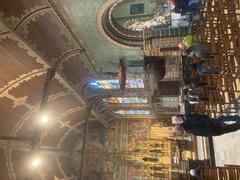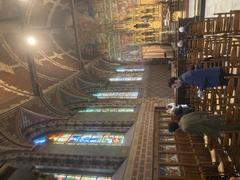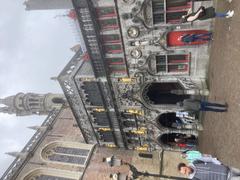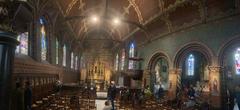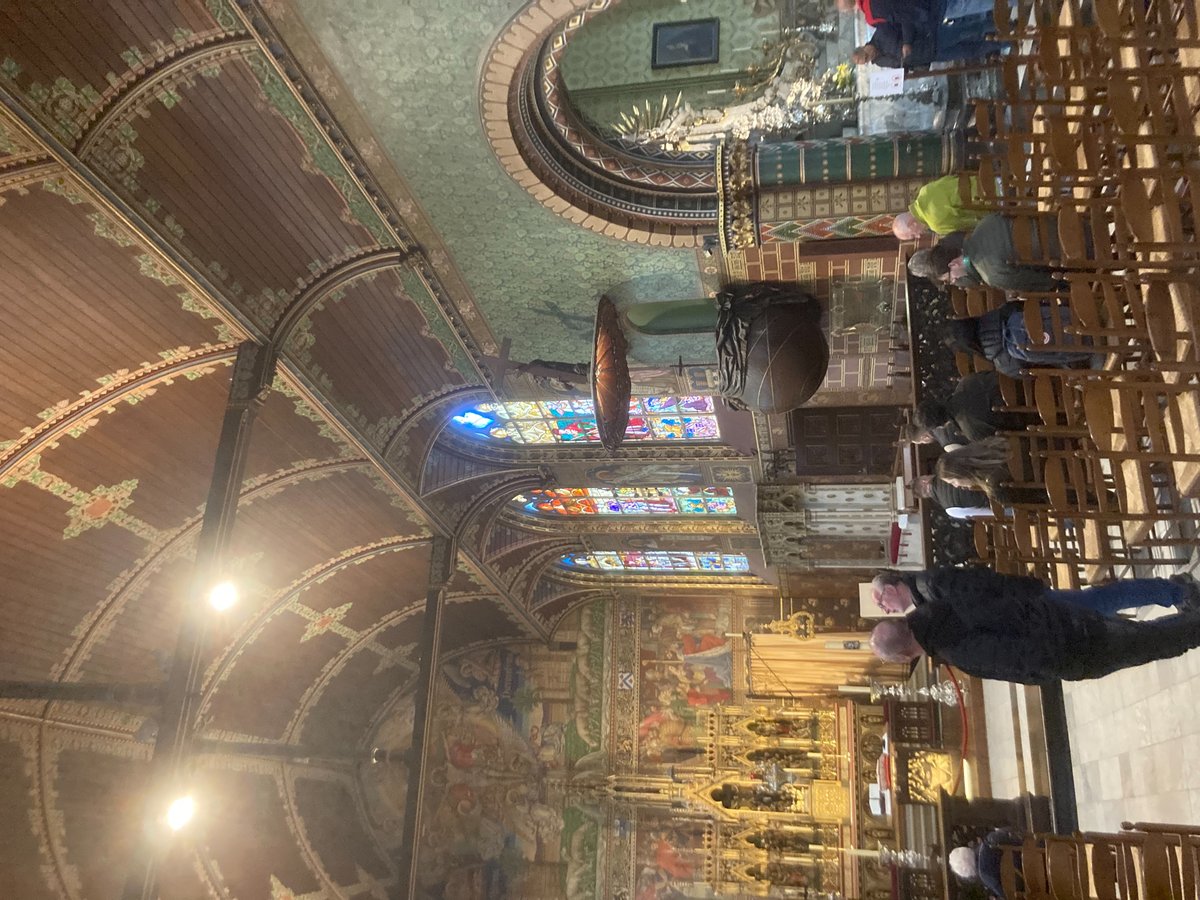
Museum Van Het Heilig Bloed: Visiting Hours, Tickets, and Historical Guide for Bruges
Date: 14/06/2025
Introduction
The Museum Van Het Heilig Bloed and its adjoining Basilica of the Holy Blood in Bruges, Belgium, are among the city’s most revered historical and religious sites. Renowned for housing a relic believed to contain the blood of Jesus Christ, the basilica is not only a center of pilgrimage but also a showcase of medieval architecture and art. This comprehensive guide provides detailed information on visiting hours, tickets, accessibility, travel tips, and highlights the basilica’s architectural and artistic treasures. Whether you are a spiritual pilgrim, a history enthusiast, or a cultural traveler, this guide will help you make the most of your visit to this iconic landmark (holy blood official; whichmuseum; visitbruges.be; museabrugge.be; Lonely Planet).
Historical Context and Origins
Foundation and Architecture
Located on Bruges’ historic Burg Square, the Basilica of the Holy Blood dates to the 12th century. It was founded by Thierry of Alsace, Count of Flanders, as part of Bruges’ transformation into a significant medieval port. The basilica consists of two chapels:
- Lower Chapel (Saint Basil’s Chapel): Built between 1134 and 1157, this is the only remaining Romanesque chapel in West Flanders, notable for its stone pillars, rounded arches, and solemn atmosphere.
- Upper Chapel: Originally Romanesque but remodeled in the 15th century into a Gothic masterpiece, this chapel features vibrant stained glass, murals, and 19th-century neo-Gothic embellishments. The two are connected by the Renaissance-style Steegheere staircase.
The Relic of the Holy Blood
The basilica’s centerpiece is a relic said to contain the blood of Christ, preserved in a rock-crystal vial encased in an ornate reliquary. According to tradition, Thierry of Alsace brought the relic to Bruges from Jerusalem in 1150, though historical records first mention it in 1256. The reliquary, made by Jan Crabbe in 1614, is a stunning artifact of gold, silver, and gemstones (holy blood official; whichmuseum).
Religious and Civic Significance
The relic quickly established Bruges as a major pilgrimage site. The annual Procession of the Holy Blood, held every Ascension Day since at least the 13th century, draws thousands of participants and spectators. This event, recognized by UNESCO as Intangible Cultural Heritage, features the ceremonial display of the relic and reenactments of biblical and historical scenes (paradeheritage; holy blood official).
Visiting the Basilica of the Holy Blood
Location and Getting There
- Address: Burg 13, 8000 Brugge, Belgium
- Accessibility: The basilica is centrally located in Bruges’ historic heart, easily reached on foot, by bus, or from the train station (Lonely Planet).
Opening Hours
- Basilica: Open daily, generally 9:30 AM – 12:00 PM and 2:00 PM – 5:30 PM.
- Relic Viewing: Typically displayed for veneration daily from 2:00 PM to 4:00 PM and Friday mornings from 10:15 AM to 11:00 AM.
- Museum (Treasure Chamber): Open 10:00 AM to 5:15 PM.
- Note: Hours may vary on holidays or during special events. Check the official website for updates.
Tickets and Admission
- Basilica: Free entry; donations welcome.
- Museum: Approximately €2.50–€3 for adults; concessions available; free for children under 12.
- Guided Tours: Available for a fee; advance booking recommended for groups.
- Procession Event Tickets: Purchase via Bruges tourism offices or the official event website (press.visitbruges.be).
Accessibility
- The lower chapel is wheelchair accessible with ramps.
- The upper chapel and museum require climbing stairs (39 steps); assistance is available but there is no elevator due to heritage protection.
- Contact the basilica in advance for accessibility support.
Visitor Etiquette
- Modest dress and quiet conduct are expected, especially during services and veneration times.
- Photography is allowed in the lower chapel and some public areas, but restricted in the upper chapel and during ceremonies.
Architectural and Artistic Highlights
Double Church Design
- Lower Chapel: Romanesque, with thick stone pillars and a 12th-century relief of the Baptism of Christ.
- Upper Chapel: Gothic and neo-Gothic, adorned with stained glass, murals, and ornate vaulting (visitbruges.be).
Artistic Treasures
- Relic of the Holy Blood: Housed in a 17th-century crystal and silver reliquary by Jan Crabbe, paraded annually during the Procession of the Holy Blood (whichmuseum).
- Great Shrine of the Holy Blood: 30 kg of gold and silver, adorned with over 100 gems.
- Paintings and Tapestries: Works by Flemish Primitives such as Pieter Pourbus, and a 1637 tapestry depicting biblical scenes.
- Sculptures: Includes the 14th-century Sedes Sapientiae (Madonna and Child) and processional statues used in the annual procession.
- Embroidered Liturgical Vestments: Finely crafted mantles from the medieval period (okv.be).
- Prints and Lithographs: Notable 19th-century lithographs depicting the relic (museabrugge.be).
Major Events and Living Traditions
The Procession of the Holy Blood
- When: Annually on Ascension Day.
- What: UNESCO-listed event with over 1,700 participants, including clergy, townspeople, and musicians, reenacting biblical stories and parading the relic through Bruges (paradeheritage).
- Visitor Tip: Plan ahead as the city center becomes crowded during the procession.
Liturgical Calendar
- Feast of the Holy Blood: First Monday after May 1st, marked with special masses and extended veneration hours.
- Daily Masses: The basilica remains an active place of worship with regular services.
Practical Visitor Information
Facilities and Amenities
- Restrooms and cloakrooms available nearby.
- Cafés, restaurants, and shops located in Burg square and the vicinity.
- Information panels and guided tours in English, Dutch, French, and German.
Travel Tips
- Visit on weekday mornings or late afternoons to avoid crowds.
- The 2:00 PM relic viewing is the most popular and busiest time.
- Combine your visit with other nearby attractions: Belfry of Bruges, Markt, City Hall, and Groeningemuseum.
Summary Table: Museum Highlights
| Treasure/Artwork | Date/Period | Artist/Maker | Medium/Material | Notable Features |
|---|---|---|---|---|
| Relic of the Holy Blood | 12th century relic | — | Crystal vial, cloth | Central to basilica’s veneration |
| Great Shrine of the Holy Blood | 1614 | Jan Crabbe | Gold, silver, gemstones | 30 kg, 100+ gems, annual procession |
| Choir Mantle of Lieven Hughenois | Medieval | — | Embroidered textile | Gold/silver thread, liturgical use |
| Tapestry | 1637 | — | Textile | Biblical/historical scenes |
| Sedes Sapientiae (Madonna and Child) | Early 14th century | — | Polychrome wood | Romanesque devotional sculpture |
| Processional Statues | c. 1900 | — | Wood | Used in annual Holy Blood Procession |
| Lithograph of the Relic | 19th century | A. Ancot (after 1631) | Relic with angels and religious symbolism | |
| Paintings by Pieter Pourbus | 16th century | Pieter Pourbus | Oil on panel | Flemish Primitive, religious themes |
Frequently Asked Questions (FAQ)
Q: What are the visiting hours of the Basilica of the Holy Blood?
A: Generally, 9:30 AM – 12:00 PM and 2:00 PM – 5:30 PM. The relic is displayed daily from 2:00 PM to 4:00 PM and Fridays from 10:15 AM to 11:00 AM.
Q: How much are the tickets?
A: Basilica entry is free; museum admission is about €2.50–€3.
Q: Is the basilica wheelchair accessible?
A: The lower chapel is accessible; the museum and upper chapel require stair climbing.
Q: When is the Procession of the Holy Blood?
A: Annually on Ascension Day.
Q: Where is the basilica located?
A: Burg 13, 8000 Brugge, Belgium.
Q: Are guided tours available?
A: Yes, in multiple languages; book in advance for groups.
Q: Is photography allowed?
A: Permitted in the lower chapel and some areas; restrictions apply in the upper chapel and during ceremonies.
Plan Your Visit
- Official Basilica Website: https://www.heiligbloedbasiliek.be
- Bruges Tourism Office: https://www.visitbruges.be
- Visitor Information and Tickets: https://www.holyblood.com/
- Procession Details: https://paradeheritage.com/belgium/the-procession-of-the-holy-blood
Download the Audiala app for audio guides and up-to-date information. For more tips and updates, follow us on social media.
Conclusion
The Basilica of the Holy Blood and the Museum Van Het Heilig Bloed offer a remarkable synthesis of faith, art, and history. From its legendary relic and awe-inspiring architecture to its world-famous procession and rich museum collections, this Bruges landmark is a must-visit for anyone interested in European heritage. Plan your visit using this guide, respect the site’s solemnity, and immerse yourself in the living traditions and artistic marvels that have defined Bruges for centuries.
Sources and Further Reading
- Basilica of the Holy Blood in Bruges: Visiting Hours, Tickets, History, and Travel Tips, 2024
- Visiting the Holy Blood in Bruges: Hours, Tickets, and Cultural Significance, 2024
- Basilica of the Holy Blood in Bruges: Visiting Hours, Tickets, History, and Museum Treasures, 2024
- Basilica of the Holy Blood Visiting Hours, Tickets, and Visitor Guide in Bruges, 2024
- The Procession of the Holy Blood, UNESCO Intangible Cultural Heritage
- Museum of the Holy Blood - WhichMuseum
- Treasures of the Basilica of the Holy Blood - Musea Brugge
- OKV: Het Museum van het Heilig Bloed
- Basilica of the Holy Blood - Wikipedia
- Basilica of the Holy Blood - Trip.com
